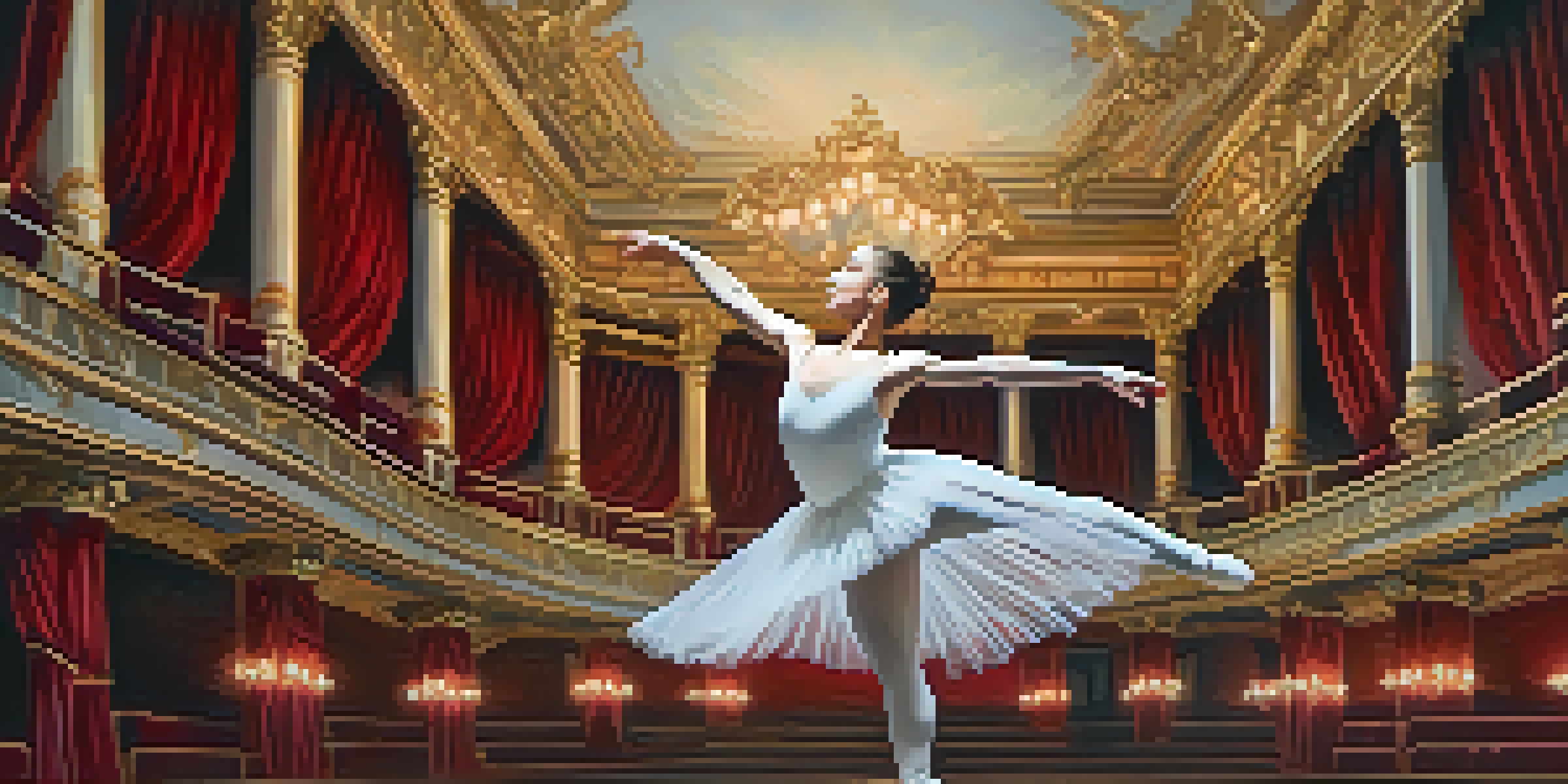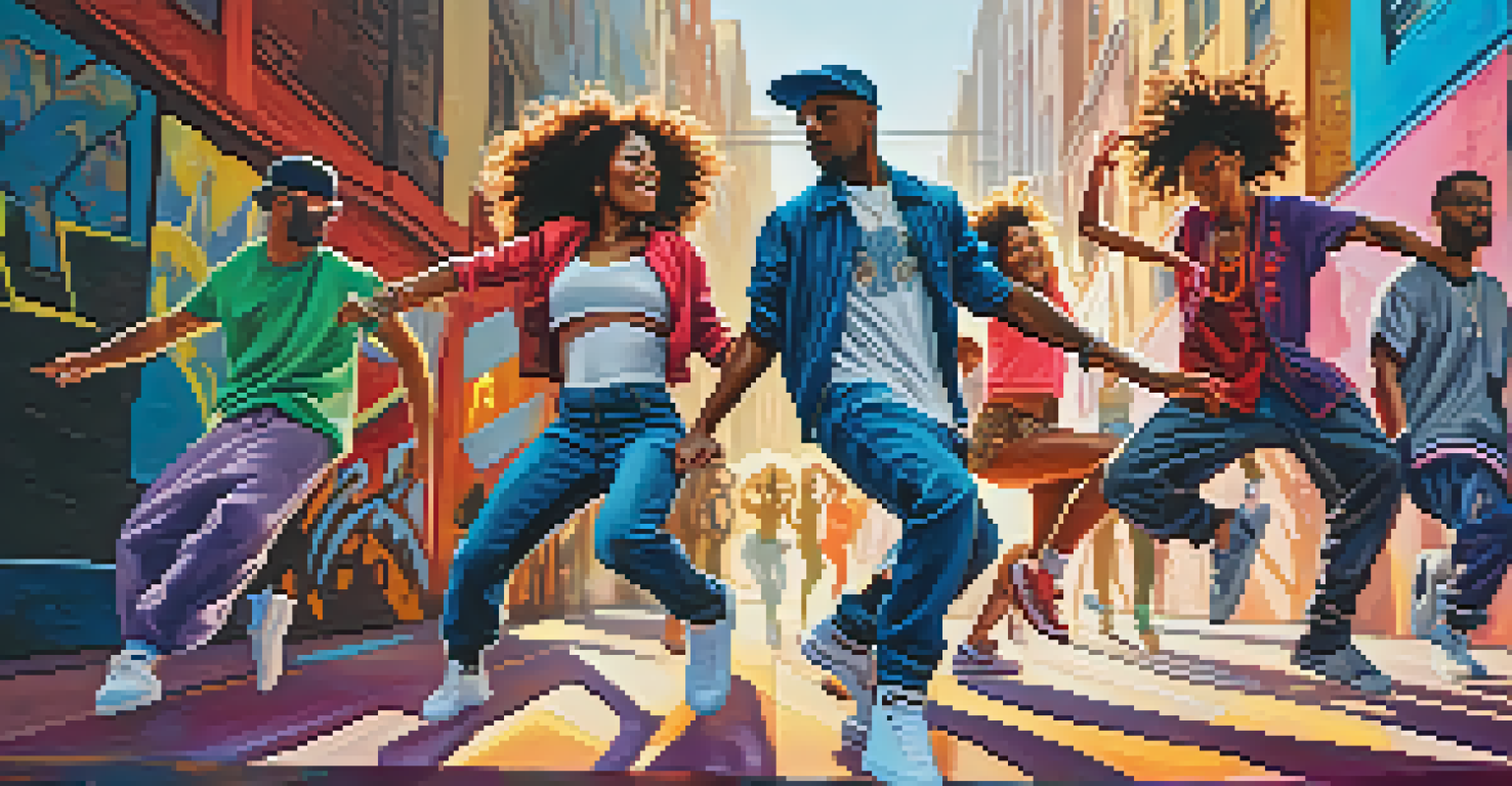Choreography in Film: The Art of Dance on Screen

Understanding Choreography's Role in Film
Choreography in film is more than just movement; it's a powerful storytelling tool. It brings characters to life, expressing emotions and intentions that dialogue sometimes can't convey. Just think of a dramatic dance scene: every twirl and leap can reflect a character’s inner turmoil or joy, deepening our connection to their journey.
Dance is the hidden language of the soul.
In many films, choreography serves as a visual metaphor, enhancing themes and narratives. For instance, in 'Black Swan,' the intense ballet sequences mirror the protagonist's psychological struggles, illustrating her descent into madness. This blend of art forms shows how dance can elevate a film's emotional resonance.
Moreover, choreographers collaborate closely with directors to ensure that the movement aligns with the overall vision of the film. This teamwork creates a seamless integration of dance and narrative, making the choreography feel like an essential part of the story rather than an isolated spectacle.
The Historical Evolution of Dance in Cinema
The use of dance in film has evolved dramatically since the early days of cinema. Initially, dance sequences were often standalone performances, like the famous Fred Astaire and Ginger Rogers routines, which showcased their incredible talent. These moments captivated audiences, but they often felt disconnected from the film's narrative.

As filmmaking techniques advanced, choreographers began to weave dance more intricately into the storyline. Films like 'West Side Story' and 'Chicago' changed the game by integrating dance into the plot, using it to advance the story and develop characters. This shift helped audiences see dance as an essential narrative element rather than just entertainment.
Choreography Enhances Storytelling
Choreography serves as a powerful tool in film, expressing emotions and advancing narratives beyond what dialogue can convey.
Today, dance in film continues to evolve, influenced by various genres and styles. From contemporary dance in 'La La Land' to hip-hop in 'Step Up,' the diversity of choreography reflects cultural shifts and audience preferences, ensuring that dance remains a vital part of cinematic storytelling.
Iconic Dance Scenes That Shaped Film History
Certain dance scenes have left an indelible mark on film history, becoming iconic moments that resonate with audiences. One prime example is the 'Time Warp' from 'The Rocky Horror Picture Show,' which not only showcases memorable choreography but also invites audience participation, creating a unique viewing experience.
Choreography is a reflection of the spirit of the time.
Another landmark moment is the dance sequence from 'Singin' in the Rain,' where Gene Kelly dances joyfully in the rain. This scene not only highlights his incredible talent but also encapsulates the film's spirit of optimism and romance, making it unforgettable for audiences.
These iconic moments often inspire new generations of filmmakers and dancers. They remind us of dance's power to convey emotion and create lasting memories, illustrating how choreography can transcend time and resonate across cultures.
The Collaboration Between Choreographers and Filmmakers
Successful choreography in film relies heavily on collaboration between choreographers and filmmakers. Choreographers must understand the director's vision to create movements that enhance the story. This partnership ensures that every step, kick, or spin serves a purpose within the narrative framework.
Moreover, choreographers often need to adapt their styles to fit the film's genre and tone. For instance, a romantic film may call for graceful, flowing movements, while an action film might require more dynamic and aggressive choreography. This versatility showcases the choreographer's skill and ability to innovate.
Dance Evolution Reflects Cinema's Growth
The integration of dance into film has evolved from standalone performances to essential narrative elements, showcasing character development.
This collaboration also extends to the actors, who must embody the choreography authentically. Training and rehearsals are crucial, as they help performers connect with the dance on an emotional level, ensuring that the movements resonate with viewers and enhance the overall narrative.
Choreography in Different Film Genres
Choreography is not confined to musicals; it plays a significant role across various film genres. In action films, for example, choreographed fight scenes often draw from dance techniques to create fluidity and rhythm. This blending of styles enhances the visual impact, making the sequences more engaging.
In romantic comedies, dance often acts as a vehicle for character development and connection. Think of the dance scenes in '10 Things I Hate About You,' where movement becomes a way for characters to express their feelings and deepen their relationships, adding layers to the story.
Even in dramas, choreography can enhance the emotional weight of a scene. In films like 'A Star is Born,' the use of dance not only showcases talent but also reflects the characters' journey, highlighting their struggles and triumphs through movement.
The Impact of Technology on Dance in Film
Technology has dramatically transformed the way choreography is captured and presented in film. From advanced camera techniques to digital effects, filmmakers can now create visually stunning dance sequences that were once unimaginable. This evolution allows for more creativity and experimentation in choreography.
For instance, the use of motion capture technology has opened up new possibilities for animating dance in films like 'The Polar Express.' This technique captures the nuances of human movement and translates them into animated characters, creating a unique blend of dance and animation.
Collaboration Is Key in Film Choreography
Successful choreography relies on the collaboration between choreographers, filmmakers, and actors to create movements that resonate with the story.
Additionally, editing technology allows choreographers to enhance performances by manipulating speed, angles, and transitions. This capability can intensify the emotional impact of dance sequences, making them memorable and visually striking.
The Future of Choreography in Film
As the film industry continues to evolve, so too will the role of choreography. With the rise of streaming services and digital platforms, there are more opportunities for diverse storytelling through dance. This shift could lead to innovative choreography that reflects a wider range of cultural influences and contemporary themes.
Moreover, the fusion of dance with technology will likely play a significant role in the future of film choreography. Virtual reality and augmented reality could create immersive experiences where audiences can interact with dance in ways we've never seen before. Imagine being part of a dance scene, experiencing the movement firsthand.

Ultimately, the future of choreography in film promises to be exciting and dynamic. As artists push boundaries and explore new mediums, we can look forward to a rich tapestry of movement and emotion that continues to enhance storytelling in the cinematic world.